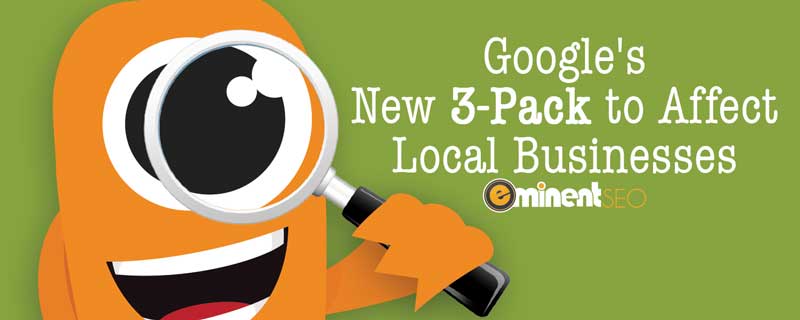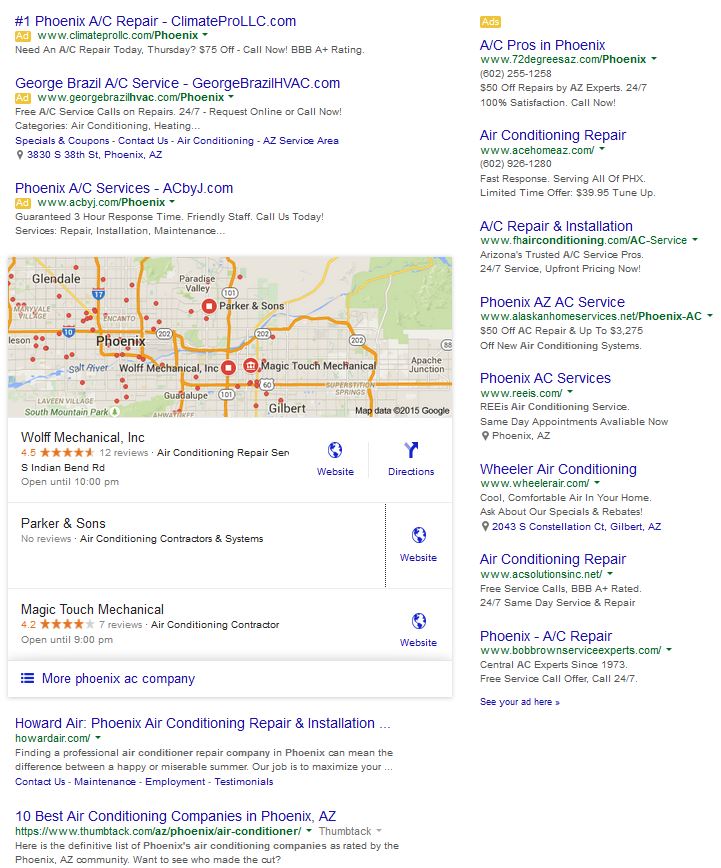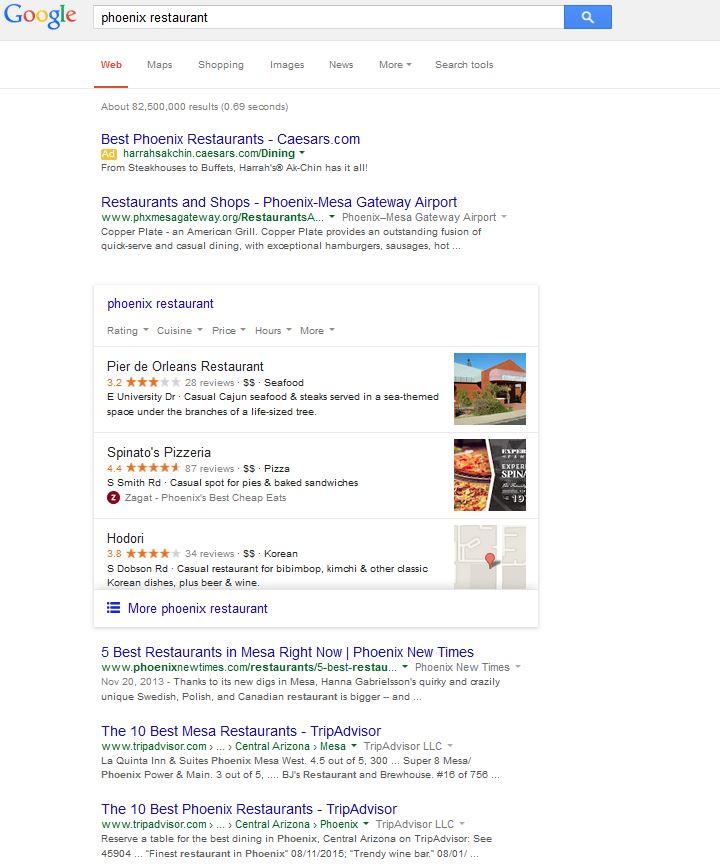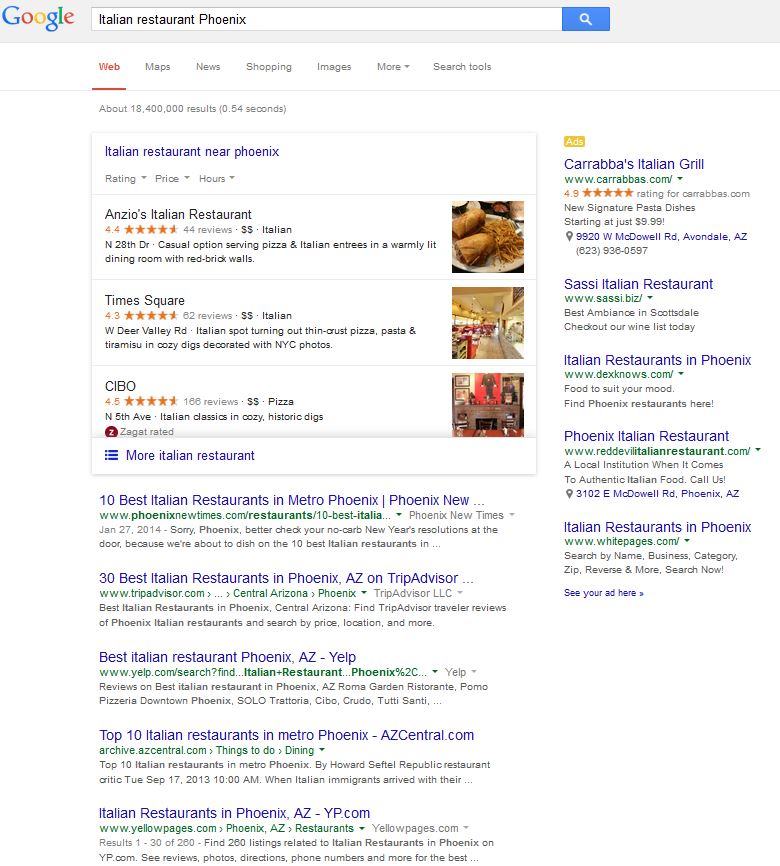Among all the changes happening at Google, the tech giant made a significant shakeup in local search earlier this month that kind of went under the radar.
For starters, the company separated Google+ from YouTube, meaning you no longer have to have a G+ account to log in to YouTube. Then, Google+ Photos starting shutting down on August 1 in favor of the standalone service known as just Google Photos. After that, of course, Google announced a new parent company, Alphabet, had been created.
Lost in the midst of all of that was a potentially major change to local search results on Google. Last week, Google shrank its traditional 7-pack in local searches to a 3-pack.
What’s Changed in Google Local Search
Not only do companies with a local focus have to do everything they can to optimize their websites and end up on the first page of Google’s search results, but, until recently, a select seven businesses got an extra-special, front-and-center placement.
The Google 7-Pack Is Now the 3-Pack
When conducting a search for a local service, Google used to feature seven businesses between the paid spots at the top of the first page and the rest of the organic search results below. Those seven businesses had verified Google+ pages that were tied in to their websites, and they presumably had put the best local SEO practices in place.
However, the 7-pack has now been truncated to a 3-pack, and some of the features thereof have been simplified, if not stripped down. Let’s look at a couple of examples. If I search for a “Phoenix AC company” in Google, this is what I immediately see:
On the first results page, you can see the pay per click spots at the top (along with some other paid ads on the right sidebar) and then a small map and the 3-pack immediately below. There’s a slight variation to this format depending on what you search for, what device you’re using, and where you’re located.
If I’m looking for somewhere to eat and I type in “Phoenix restaurant,” I’ll get a page that has just one paid ad at the top with the first organic result appearing just above the 3-pack.
If I wanted to be a little more specific in my search, I could type in “Italian restaurant Phoenix” and see the 3-pack at the very top with some ads on the right-hand side.
Google actually used to have a 10-pack on the first page of search results at one point, so the search engine’s recent move to a 3-pack marks its second truncation of the feature. As you can see, the 3-pack’s placement on the page differs by search, as does the number of ads you see on the sidebar, and this format could change slightly as time goes on. You could search the same term in the morning and again at night and possibly see a variance of the format. Google never lets all of its secrets and rationale out of the bag.
With the change to a 3-pack, Google also brought back the “More (search term)” link right below the last business in the spotlight, as you can see in the three examples above. If you click on that link, it will take you to a map of businesses in that industry in the geographic area you searched. Each page on the map lists 20 results, with the first three listings on page one corresponding to the 3-pack.
Other Features Removed: Addresses, Phone Numbers, Google+ Links
The new 3-pack has a sleeker look than the 7-pack, but some of the information that used to be listed for each business is no longer present. Most notably missing are the full addresses and phone numbers of each business. Presumably, you could have done a search before and dialed up a business of your choosing without having to visit any individual websites. Now, the Google 3-pack encourages you to either visit the websites of the featured businesses or get directions (if applicable) to their location.
Also noticeable in the move from a 7-pack to a 3-pack is the lack of a Google+ link for each business. There’s now no easy way to get to the Google+ page of any of the three in the spotlight. In fact, if you click directly on the name of one of the three companies, it will take you to the aforementioned map.
A Couple of Features Added: Ratings, Business Hours
Google used to only show how many reviews each business in the 7-pack has received (formerly seen as “Google reviews,” now just called “reviews”), but you can now see the rating for each company out of five stars, if there are any reviews. You can also now see the business hours of some in the 3-pack, which will basically tell you what time the company opens up next or, if it’s currently open, what time it closes.
The 3-pack is also more visual than the 7-pack. Besides the snappy symbols that link to the websites of and directions to each business, you might see a photo for some of the companies on the right-hand side of the spotlight. Also, as seen in the first search example, a map might appear above the 3-pack, depending on your search. When Google had a 7-pack, a map usually appeared in the right half of the page, but it wasn’t as visually connected to the spotlight as it is with the new 3-pack.
What the Google 3-Pack Means for Local Businesses
You can bet more companies will be fighting tooth and nail to get slotted in the 3-pack, but all hope shouldn’t be lost if your business can’t quite make it in there.
First-Page Organic Search Results Expanded
When Google produced a 7-pack on page one of your search results, the number of organic, non-7-pack results shrank to 6 or 7, and all were generally below the fold. However, the number of organic results outside of the new 3-pack has been expanded to 10. It’s uncertain at this time if Google simply dropped four from the 7-pack into the organic list immediately below, but this shift may mean that there’s more room for your business to work its way onto page one. If you do make it onto the first page, a strong meta title and description is going to be key.
Google+ Business Pages De-Emphasized for Local Search?
If you didn’t have a business Google+ page before or couldn’t get it verified that it corresponds with your website, Google may no longer be holding your website hostage in the search rankings, as it looks like the company is slowly backing off holding its own social network over users’ heads. This notion still hasn’t been confirmed, so, at this time, we’d recommend keeping your Google+ business page active and continually updated. However, if it’s true that a Google+ business page no longer has any bearing on one’s search rankings, then the field would be leveled for more businesses to contend for a spot on page one, which generates around 90 percent of the search traffic.
Closing Speculation
This major local search change has got many marketers speculating what the future will hold for local businesses. By shrinking the local pack to 3 spots instead of 7, the first page of results shows only Google-approved products above the fold. Could local rankings eventually become ad placements since Google+ didn’t work out?
Share your thoughts on the future of Google local placement in the comments below! If you’d like to learn more about how Eminent SEO can boost your local marketing efforts, including optimizing your website for Google, keep reading: local business marketing.







Google Plus is one of the best free tool which we can have when we think of SEO and that too it’s a Google. Keeping GMB pages active is very important otherwise Google may deactivate them if these were updated long back or never ever used. Local ranking is essential for any business and previously with the 7 pack display it was less competitive than the current 3 pack display. Google has removed the G+ page link, so now you have to have a website to get listed on the 3 pack. Be active, be relevant, keep building consistent authoritative NAP citations and keep getting good reviews to stay ahead on local search.
Regards
Sonia Pitt
PromozSEO
Thanks for your comment! We used Trails (, ) on both iPhones. We were definitely still in 2G & 3G coverage areas for the entire test. We plan on doing some further exeeirmpnts in slightly more remote locations, so we should have some more information in the future.